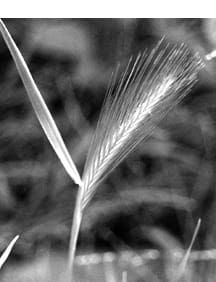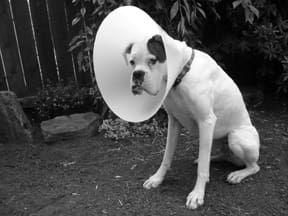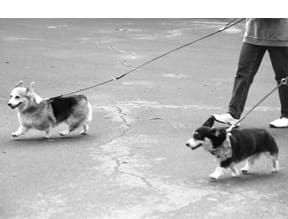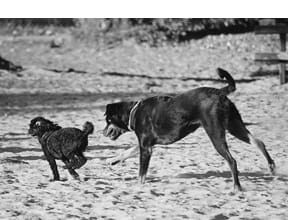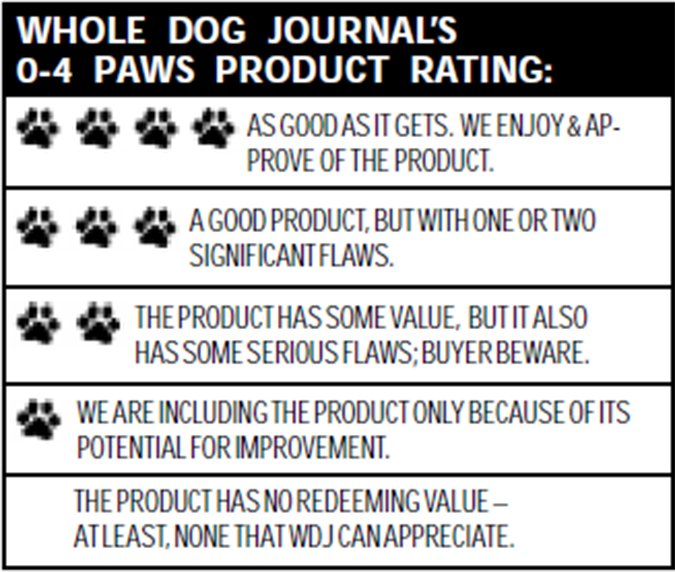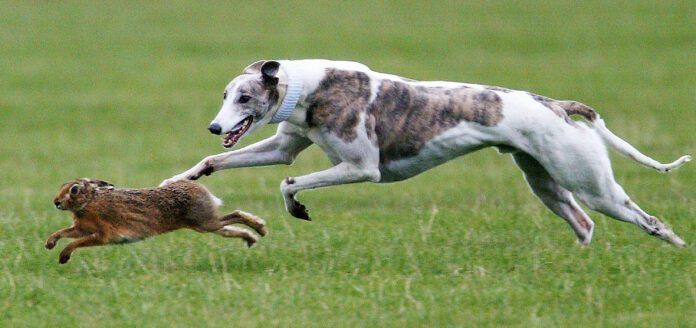FOXTAILS AND DOGS: OVERVIEW
1. If you don’t know what foxtails look like, ask another dog owner to point them out to you.
2. Eliminate foxtails in your yard; organize a foxtail-pulling party at your local dog park.
3. At the height of foxtail “season” (when the plants are dry), avoid walking your dog in infested areas.
4. Thoroughly examine your dog after walks in foxtail areas.
One day in early May, my husband and I took Lucky, our 15-month-old Belgian Shepherd mix, for an off-leash hike at a regional park near our Oakland, California, home. Lucky was playing Fearsome Predator, stalking us in the tall grasses near the trail and then tearing off at full speed.
We were laughing at her antics when a fellow hiker stopped to watch.

“That’s really cute,” the woman said, “but you should watch out for foxtails when the weather gets warmer.”
Huh? Foxes?
“No, foxtails,” she repeated. “Those weeds over there. When they get dry the seeds can get in dogs’ ears or up their noses, which means an expensive vet visit.”
She was gesturing to a stand of green, fuzzy, tall grass that looked distinctly unthreatening.
“Is this your first dog in California?” she asked at our perplexed looks. We nodded; both of us had grown up on the East Coast. “Foxtails get to be a big problem out here,” she explained. “Starting in June, I won’t be walking my dog here again until fall.”
We thanked her and she hiked on. Foxtails? Interesting. I resolved to learn more.
Three weeks later I did – the hard way. During another off-leash hike, Lucky chased a lizard and got a mouthful of that fuzzy grass, which was now turning brown and sere. After that, she kept trying to eat grass – the regular kind, not the foxtail. And in the car on the way home, she began hacking and coughing alarmingly. I called our veterinarian and told her what happened.
“Foxtails? Bring her in immediately!” she ordered.
When we arrived, an assistant gave me a rapid-fire explanation of what they might have to do: sedate Lucky, reach into her mouth and throat and attempt to remove any lodged foxtails with a special instrument.
Just then, Lucky vomited. Up came the grass she’d eaten – along with six prickly foxtail seeds. The veterinarian and her assistant were thrilled. A subsequent exam of Lucky’s throat and mouth suggested the coast was now clear. She was still hacking occasionally, but the vet believed it was just from the irritation the foxtails had caused. Any that Lucky had actually swallowed, she said, should pass through without too much trouble, although I was to keep a close eye on her.
The storm passed – as did another four foxtails! – but it taught me a lesson: these subtle little seeds could cause big problems. And many dog owners aren’t aware of the potential dangers: irritation, infection, chronic illness, and in some cases, death.
Foxtail Facts
“Foxtail” is a generic term that’s often applied to several species of wild grasses, but is specifically associated with a type of wild barley (Hordeum jubatum) that is indigenous to the western United States.
Foxtail is common all up and down the West Coast but has also spread across the country, according to the U.S. Forest Service, populating all but seven states: Florida, Georgia, Hawaii, Louisiana, North Carolina, South Carolina, and Virginia. It’s also found throughout most of Canada, as well as in some areas of Mexico.
The weed tends to grow in grassland areas and is common along roadsides, trails, and areas that include human disturbance, such as dumps. It also grows well along the edges of salt marshes, on flatlands and Western prairies, and in irrigated meadows.
Foxtails grow quickly with winter and spring rains. As they mature, a seed forms at the top of the stalk. With its, soft, bushy appearance, the seed, which is comprised of numerous seed heads, looks like a fox’s tail – hence the name.
As the plant begins to dry out in the summer months, the seed heads, also known as awns, become brittle and fall off the plant. As they continue to dry, the long foxtail breaks into smaller and smaller segments, with each sharp-pointed awn sporting a few long bristles. Viewed under a magnifying glass, each bristle is covered with an infinite number of microscopic barbs. If an animal brushes by the dry plant (or steps on it, sniffs it, rolls on it, lies on it, ad nauseum), the microscopic barbs catch on its fur.
Sometimes the awn falls from the animal’s fur on its own. However, if the awn doesn’t fall out, or it hooks into another area of the animal, that’s when the trouble starts.
Foxtails are Designed to Burrow
Catherine Dyer, DVM, diplomate of the American Board of Veterinary Practitioners and a lecturer at the University of California, Davis School of Veterinary Medicine, says it’s the barbs that make the awns so dangerous.
“Any kind of plant awn could potentially be a problem, but the classic foxtail seems to be the worst,” she says. “It has a point so it can penetrate and go up into little orifices, and it migrates in one direction – it doesn’t go backward.”
If you pick up a foxtail awn and stroke it with your fingers, you’ll quickly learn why this plant is so dangerous to dogs. The microscopic barbs facilitate the awn’s movement in one direction, following the sharp point of the seed. But you can’t rub the bristle the other way; the tiny barbs catch and prevent the backward movement of the bristle. If you force it, the bristle breaks off, leaving the rest of the awn behind.
Dogs often pick up foxtails between their toes; the flexing motion of the dog’s feet helps the foxtail work deeper and deeper between the toes, until it pierces the skin (and keeps going). It’s also extremely common for dogs to get foxtails in their nostrils as they sniff and smell in the grass on a walk. Other common foxtail sites for foxtails to embed include the dog’s ears, eyes, and throats.
“They can swallow them or actually aspirate them into the airways, which is very dangerous,” says Dr. Dyer.
Foxtails have also found their way into dogs’ anuses, vaginas, penile sheaths, or open wounds.
Once inside the dog, awns continue to burrow inward. If they’re not found and removed quickly, they can literally disappear, because they won’t show up on an x-ray. An awn that has crept into the dog will continue to travel throughout her body, often leaving a hollow tract behind it, until it either comes up against something it can’t go through (such as bone), or pops out through the skin.
Foxtails cannot be absorbed by the dog’s body, nor can they be broken down or digested, says Dr. Dyer, although if an awn is swallowed and reaches the stomach, it will probably just pass through. Foxtails that insinuate their way deep into the dog’s body can be there to stay. Autopsies have discovered foxtails in dogs’ glands, hearts, brains, lungs, livers, and other organs.
Detailing the Dangers of Foxtails to Dogs
The two main dangers posed by foxtails are foreign-body reactions and infections, says Dr. Dyer. The levels of the threat range from irritating, as when a foxtail invades the webbing between a dog’s toes and causes an abscess, to medical emergencies.
“What’s really dangerous is when they penetrate the body wall through the chest wall or the abdominal wall,” she says. “Those cases are life-threatening.”
Even if the body cavity isn’t penetrated, foxtails can lead to serious consequences.
Randy Acker, DVM, author of Field Guide to Dog First Aid: Emergency Care for the Outdoor Dog and owner of the Sun Valley Animal Center in Ketchum, Idaho, frequently treats dogs who’ve tangled with foxtails. He says even an awn lodged in the nose can be deadly serious if not removed.
“If foxtails get deep into the nasal passages, they can continue to travel into the brain and cause seizures or death,” he says.
Foxtails can also cause tissue necrosis.
“Then something like aspergillosis (a common fungus) can grow in dead tissues,” says Dr. Acker. “Once established, it’s pretty devastating; it can be as serious as cancer.”
Foxtails in the ears can rupture eardrums or cause chronic ear infections, while foxtails in the eye can lead to blindness. Inhaled foxtails can affect the lungs, causing infections and necessitating major surgery – including the removal of lung lobes.
Even if the foxtail doesn’t cause the problem, it can create a conduit for outside infection. Dirt-borne bacteria, such as Actinomyces bovis and Nocardia asteroides, can be introduced into the body cavity by a burrowing awn and can wreak havoc. Pneumonia is not an uncommon result when an awn enters a lung.
Discospondylitis, an infection of the spinal vertebra and intervertebral discs, can be introduced by foxtail migration, according to the Southern California Veterinary Surgical Group. Foxtails can cause conjunctivitis if they become lodged in the eye. And a number of other opportunistic infections, such as blastomycosis, can occur when an awn enters a dog’s body.
Which Dogs are at Risk?
Almost any outdoor dog can encounter foxtails. Dogs with long fur are more likely to pick up and retain foxtails than their short-haired brethren, although foxtails can latch on to the fur between any dog’s paws and are indiscriminate when it comes to nostrils and other orifices. Prick-eared dogs may be more likely to get foxtails in their ears than dogs with hanging ears.
At particular risk are dogs who spend a good deal of their time out in the field. Michael Guerin, a physician and hunting enthusiast who lives in South Dakota, discovered this firsthand a few years ago with his English Pointer, Tess. After a long and successful hunting season, he discovered a lump along the dog’s ribcage.
Guerin’s kept an eye on the lump, which he said felt rather hard, unlike a typical abscess.
“After a couple of days it was probably golf-ball sized,” he said. “English Pointers have a tendency to get rhabdomyosarcoma, so I thought, ‘Oh, maybe it’s cancer.’ ”
His vet removed the lump and a biopsy turned up no cancerous cells. The vet suggested there had been a foreign body in there but found no sign of it. But Guerin wasn’t satisfied and asked to see the pathology report, which included a reference to a tract. Something clicked in his mind.
“I’d never had a dog with foxtail, but I’d read an article probably 15 years ago about a dog that had a foxtail that came out the eye and it mentioned tracts,” he said. “So as soon as I saw that it said ‘tract’, I thought, I bet that’s what the dog had.”
Meanwhile, the wound wasn’t healing well. A small hole marked its center and it continued to drain fluid. Guerin brought Tess to another vet for a second opinion and shared his foxtail theory. Sure enough, in a five-hour exploratory procedure the vet discovered an awn lodged in the pleura of a lung – dangerously close to the lung itself.
The experience was a wakeup call for Guerin, and when one of Tess’s pups, Annie, developed a similar lump a year later, he didn’t hesitate.
“I found another vet who had had experience with foxtails,” he said. “So that dog was operated on by her and they got it out while it was still relatively shallow.”
Guerin has become far more vigilant with his hunting dogs as a result.
“As much as possible, I’ll avoid grasses that have awns,” he said. “But there’s always going to be some foxtail around there, and if they happen to be hunting in foxtail, I’ll check them over thoroughly afterward.”
How to Prevent Foxtail Problems for Your Dog
1. Avoid foxtail-infested areas in “foxtail season”- from early summer, when foxtails and surrounding grasses start to dry, until the fall or winter wet season eliminates the foxtail threat.
2. If you must walk your dog in areas where foxtails grow, keep him on leash and on the trail to help reduce his chances of encountering the awns.
3. To keep your dog from inhaling or ingesting a foxtail awn, don’t allow him to play fetch anywhere near foxtails. Don’t allow hunting or tracking dogs to sniff around foxtails.
4. If you have foxtails in your yard, keep the plants mowed while they are still green to help prevent them from going to seed. Better yet, pull the grasses up by hand and
deposit the whole plants directly into a garbage bag or compost bin.
5. If your dog is long-haired, trim all the hair between his toes, over the top of his toes and feet, from his legs, around his ears, his vent, and his belly. Short hair helps deny the foxtails the resistance they need to migrate deeper into the dog’s skin.
6. Keep your dog well groomed. Foxtails readily work their way into mats, but can be easily brushed out of a clean, untangled coat.
7. Most importantly, after every outdoor experience in a foxtail zone, check your dog from head to toe. Examine the space between each and every toe and underneath
his feet. Look in his armpits, groin, anal area, and ears.
8. Keep alert for suspicious lumps, bumps, or swellings on your dog. Look for limping or excessive licking of toes, head-shaking, sneezing, or a glued-shut eye.
9. If your dog exhibits any of the symptoms of having a foxtail, take him to a veterinarian as soon as possible – that day!
The Foxtail Reality Check
So how often does the worst-case scenario occur? While she has no hard-and-fast numbers on mortality rates as a consequence of foxtail-related illnesses, Dr. Dyer says the extremes are rare.
“Deaths would be the exception, although certainly we have them,” says Dr. Dyer. “Foxtails into the body cavity would probably be the least common problem we have.”
It’s much more likely for a dog to suffer a foxtail in the nose, ear, or paw.
“Depending on where it is in the body, many times you remove it and you’re done with it,” she says. “If it’s gotten inside and created an infection, then you often have to treat with antibiotics.”
However, when foxtails do dig deep, the consequences for a dog – and the veterinary bills – can become daunting.
The best way to eliminate foxtail danger is to avoid it completely. If that’s not possible, there are steps owners can take to minimize the risks (see sidebar, opposite page). But with even a minor foxtail incident, a quick response is the best medicine.
“Early intervention by your vet is important,” stressed Dr. Dyer – as is an awareness of the problem. Michael Guerin speaks soberly about what might have happened to his prized hunting dog if he hadn’t suspected a foxtail was behind her problems.
“In hindsight, I am so glad I had read that article about the awn,” he said. “And people should keep things like that in mind. If you have a little bit of an index of suspicion, that’s a good thing.”
C.C. Holland is a freelance writer from Oakland, California, who enjoys applying what she learns about canine health and behavior to her own mixed-breed dog, Lucky.


